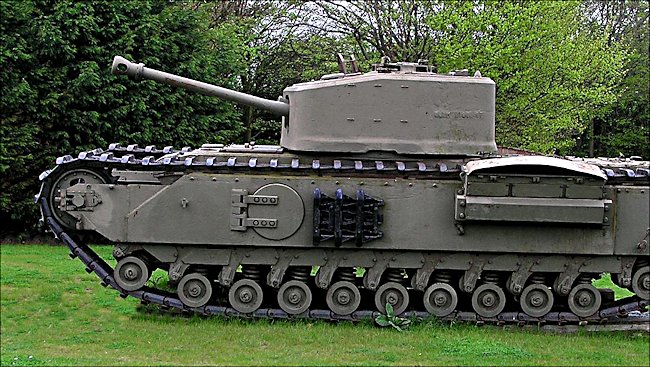Churchill Mark VII Crocodile Flame Thrower Tank
This British Churchill Crocodile Flame Thrower Tank can be found outside the Muckleburgh Military Collection, Weybourne, Norfolk, England. Their website is www.muckleburgh.co.uk.

Churchill Mk VII Crocodile Flame Thrower Tank outside the Muckleburgh Military Collection in Norfolk
Training Churchill Tank Crocodile flame thrower crews
Old versions of Churchill tanks were converted into flame-throwers. This was an old Mark I Churchill that was converted and called a Churchill Mark VII. They earn't the nickname 'Crocodile' because of the ponderous way they looked on the move, as they crossed open terrain pulling the large trailer containing the 500 gallons of fuel.
Lieutenant Andrew Wilson of the HQ Squadron, 141st Regiment Royal Armoured Corps had to sign the Secrets Act before he was allowed access to a practical demonstration of what the mysterious courses and exercises the Sabre squadrons had been involved in. Security was very tight.
"I saw a lone Churchill tank towing a trailer move towards the first target. It was a concrete pillbox. Suddenly there was a rushing in the air, a vicious hiss. From the front of the tank a burning yellow rod shot out. Out and out it went, up and up, with a noise like the slapping of a thick metal strap. The flaming rod curved and started to drop, throwing off burning particles. It struck the concrete with a violent smack. A dozen yellow fingers leapt out from the point of impact, searching for cracks and apertures. All at once the pillbox was engulfed in fire, belching, twisting, red-roaring fire. And clouds of strange smelling, grey black smoke. "

Churchill Mk VII Crocodile Flame Thrower Tank used to squirt flames out of its converted machine gun port.
British tanker Trooper Ernie Cox of the same unit also recalled what he saw at the demonstration, "It came as quite a shock for we had never seen the likes of it. The flame bounced around the corners of zig-zag trenches. The demonstration also included houses and various structures. It was profoundly sobering."
When it finished Lieutenant Wilson noticed a spot of liquid had splashed on his boot, where it clung and carried on burning however hard he tried to shake it off. In the end he wiped it off, still burning, on to the grass. "What it might do to a human being was unimaginable."
A terrible cruel but effective weapon
Ernie Cox recalled the night his Crocodile Churchill Flame-thrower tank had a ‘run-away’ flame gun during one assault. "Once the valve stuck on the flame gun it had to flame for the full two minutes until the fuel tank towed behind the Churchill became empty. There was no safe way of turning it off. We were in the middle of attacking Le Bon Repos farmhouse in the Odon valley when the valve became defective. It was a night attack."
"The jet of flame cascaded down the surrounding trees in a waterfall of flames. We felt we were about to be consumed by our own weapon. The leaves floated down like masses of fiery butterflies, the flames danced along track and still the gun was throwing out fuel. In the dark and in the gloom the smoke that we were now adding to the flames was of a dull red. It was frightening, terrifying and awesome, yet in a way exhilarating, too engrossed in the moment to have any feelings. Then it stopped, 500 gallons of fuel spent."
"The gunner’s voice came over the intercom, ‘A bigger cock-up than Dunkirk’. He was wrong. The farmhouse was ablaze from end to end, but they had seen no German defenders. Then we saw some people standing there and as we got closer we saw they were Germans. They were virtually comatose. An infantry major came across and asked us in English if we wanted to see our handiwork. There had been three hundred troops in that building ready to attack out troops. We declined his offer. The Germans just stood there in shock, no weapons, no helmets. We just left them there."
WW2 tank books

